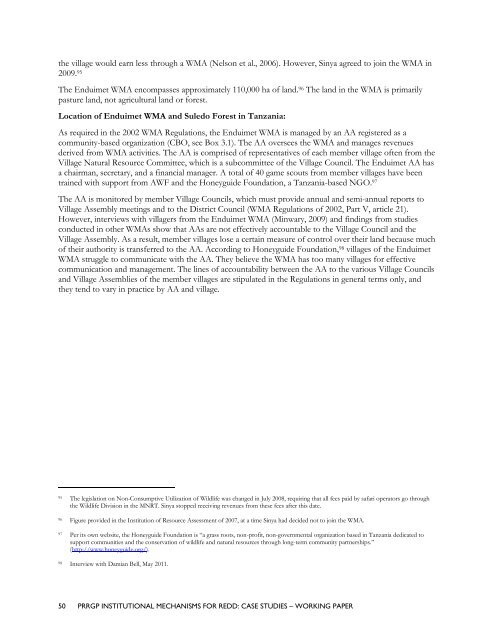Institutional Mechanisms for REDD+ - Case Studies Working Paper
Institutional Mechanisms for REDD+ - Case Studies Working Paper
Institutional Mechanisms for REDD+ - Case Studies Working Paper
Create successful ePaper yourself
Turn your PDF publications into a flip-book with our unique Google optimized e-Paper software.
the village would earn less through a WMA (Nelson et al., 2006). However, Sinya agreed to join the WMA in<br />
2009. 95<br />
The Enduimet WMA encompasses approximately 110,000 ha of land. 96 The land in the WMA is primarily<br />
pasture land, not agricultural land or <strong>for</strong>est.<br />
Location of Enduimet WMA and Suledo Forest in Tanzania:<br />
As required in the 2002 WMA Regulations, the Enduimet WMA is managed by an AA registered as a<br />
community-based organization (CBO, see Box 3.1). The AA oversees the WMA and manages revenues<br />
derived from WMA activities. The AA is comprised of representatives of each member village often from the<br />
Village Natural Resource Committee, which is a subcommittee of the Village Council. The Enduimet AA has<br />
a chairman, secretary, and a financial manager. A total of 40 game scouts from member villages have been<br />
trained with support from AWF and the Honeyguide Foundation, a Tanzania-based NGO. 97<br />
The AA is monitored by member Village Councils, which must provide annual and semi-annual reports to<br />
Village Assembly meetings and to the District Council (WMA Regulations of 2002, Part V, article 21).<br />
However, interviews with villagers from the Enduimet WMA (Minwary, 2009) and findings from studies<br />
conducted in other WMAs show that AAs are not effectively accountable to the Village Council and the<br />
Village Assembly. As a result, member villages lose a certain measure of control over their land because much<br />
of their authority is transferred to the AA. According to Honeyguide Foundation, 98 villages of the Enduimet<br />
WMA struggle to communicate with the AA. They believe the WMA has too many villages <strong>for</strong> effective<br />
communication and management. The lines of accountability between the AA to the various Village Councils<br />
and Village Assemblies of the member villages are stipulated in the Regulations in general terms only, and<br />
they tend to vary in practice by AA and village.<br />
95 The legislation on Non-Consumptive Utilization of Wildlife was changed in July 2008, requiring that all fees paid by safari operators go through<br />
the Wildlife Division in the MNRT. Sinya stopped receiving revenues from these fees after this date.<br />
96 Figure provided in the Institution of Resource Assessment of 2007, at a time Sinya had decided not to join the WMA.<br />
97 Per its own website, the Honeyguide Foundation is ―a grass roots, non-profit, non-governmental organization based in Tanzania dedicated to<br />
support communities and the conservation of wildlife and natural resources through long-term community partnerships.‖<br />
(http://www.honeyguide.org/).<br />
98 Interview with Damian Bell, May 2011.<br />
50 PRRGP INSTITUTIONAL MECHANISMS FOR REDD: CASE STUDIES – WORKING PAPER

















